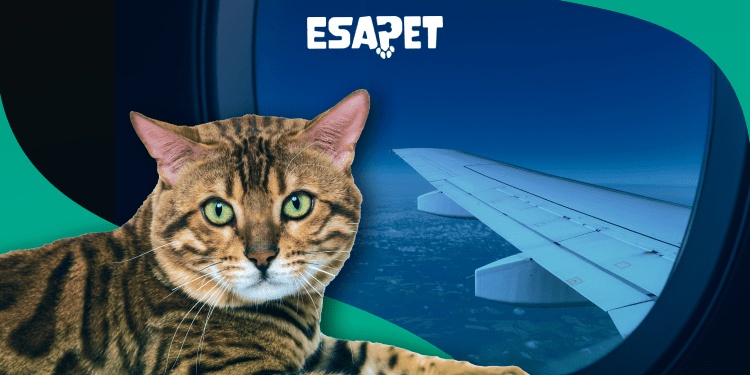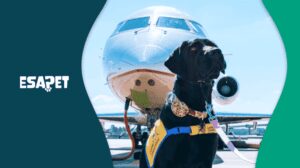Can You Bring Cats on a Plane? A Complete Guide for 2026

Traveling with pets, especially cats can often seem challenging due to the varying rules and regulations of airlines and countries. However, the answer is generally yes, with some preparation and understanding of airline policies. Air travel can be stressful for animals and their owners. However, knowing what to expect can ease much of this anxiety.
Most airlines accommodate pets in the cabin or the cargo hold. It depends on the cat’s size, breed, and the flight’s duration and destination. This guide will cover all these aspects, ensuring a smoother travel experience for you and your cat.
Can You Bring Cats on a Plane?
Yes, you can bring cats on a plane. However, you need to know that this depends on the airline’s specific policies. Most passengers can fly with cats if they follow the airline’s pet policy. It usually involves the cat being in a pet carrier that fits under the seat in front of you.
For longer flights or larger cats, they may need to travel in the cargo hold. You need to carry them in a pet carrier that complies with the airline’s regulations. Travelers must check with their airline for detailed requirements, including possible fees and documentation needed for flying.
Air Carrier Access Act
The Air Carrier Access Act (ACAA) is a critical legislation that ensures that individuals with disabilities are not discriminated against during air travel. It mandates that airlines accommodate passengers with disabilities, providing necessary services such as:
- Special seating arrangements
- Assistance during boarding and deplaning
- Appropriate handling of service animals
An essential update to the ACAA in 2021 has significant implications for those traveling with emotional support animals (ESAs). Previously, it was a requirement for airlines to accommodate ESAs in the cabin. Now, the update allows carriers to set their own ESA policies.
TAKE NOTE |
This means the ability of an ESA to travel in-cabin now varies by each airline’s specific pet policy. Passengers must check with their airline beforehand to understand the current rules and prepare accordingly. |
Emotional Support Cat
Emotional support cats are companions that provide comfort and emotional support to their owners without formal training. They play a crucial role in their owners’ mental well-being. They offer companionship to ease anxiety, depression, and loneliness.
When considering a cat as an ESA, it is essential to check its temperament. The ideal emotional support cat should be calm, affectionate, and comfortable. It is to ensure that they can provide support in different environments. Since any breed or mix can serve as an ESA, the personality of the individual cat is more important than the breed.
You must get a prescription from a licensed mental health professional to name your cat as an ESA. This prescription usually comes in the form of a detailed letter stating that the cat’s presence is essential for your mental health.
It’s important to note that one cannot classify cats as service animals like a dog under U.S. law. However, cats can qualify as therapy animals. Therapy animals help in volunteer settings like hospitals or nursing homes to comfort various people. In contrast, ESAs serve their specific owners.
For more detailed distinctions between emotional support animals and other assistance animals, explore the differences between ESA vs. Service Animals and learn about Service vs. Emotional Support Cats.
How to Get an ESA Letter for Your Cat?
Below are the detailed steps for acquiring an ESA letter for your cat and how the solutions offered by ESA Pet can assist in this process.
Step 1: Consult a Licensed Mental Health Professional
First, you need to consult with a licensed mental health professional to get an ESA letter. This could be a psychologist, psychiatrist, or other therapist licensed to practice in your state. During this consultation, the professional will identify your mental health and determine whether an emotional support cat would contribute to your treatment plan.
Step 2: Assessment of Your Need
If your mental health professional determines that you would benefit from having an ESA, they will proceed to write an ESA letter for you. This letter must state your need for the ESA. Additionally, it should confirm that you have a mental health condition as defined by the DSM-5 (Diagnostic and Statistical Manual of Mental Disorders).
Step 3: Obtain the ESA Letter
Once written, you will receive the ESA letter. This letter should include the therapist’s license number, the date of issuance, profession type, and signature. It’s important to ensure that the ESA letter contains all these elements to be considered valid.
Get your Official ESA Letter Consultation from a licensed therapist.
Get ESA Letter Now
Step 4: Using ESA Pet for Assistance
ESA Pet offers a streamlined process to assist in obtaining your ESA letter. They can connect you with licensed mental health professionals familiar with ESA regulations and provide a legitimate ESA letter upon appropriate evaluation. ESA Pet ensures that the professionals you connect with are qualified and that the ESA letters meet all the legal requirements for housing and international flights.
How to Prepare Your Cat for the Flight
Preparing your cat for a trip involves several key steps to ensure the safety and comfort of your feline friend during travel. It’s essential to address each aspect methodically to help minimize stress for you and your cat.
Health Certificate
Before flying, especially on an international flight, you’ll need a health certificate for your cat. This document, issued by a vet, confirms that your cat is fit to fly and free from contagious diseases. You must do this close to your departure date. This is because most certificates are valid for a specific time, within 10 days of examination notice.
Cat Carrier/Pet Carrier
A pet carrier is essential for traveling with your cat on an airplane. It should be airline-approved and big enough for your cat to stand, turn around, and lie down. You can put the carrier in the seat in front of you. Introduce the carriers to your cat well before the flying trip to help them get used to it.
TAKE NOTE |
Place familiar blankets, treats (food), or toys inside to make them soft-sided and feel like a safe space. Ensure the carrier is soft-sided, has extra room, and can fit under the seat in front of you as carry-on luggage. |
Litter Box
Consider a portable leak-proof litter box for the entire trip that can fit within the cat carrier/kennel. Train your cat to use the portable litter box at home before the trip. Keeping a supply of paper towels in your carry-on is handy for cleaning up any accidents on planes.
How Can You Coordinate With the Airline Before Your Trip?
Coordinating with the airline before your particular flight is crucial. This is to ensure a smooth experience when traveling with your cat. Here’s how you can coordinate with most airlines before your international or short trip:
- Confirm Pet Policy: Different airlines have different policies about pet travel. Contact your ticket company as early as possible to understand their specific requirements for flying with a cat. This includes fees, pet carrier box specifications, and any pet restrictions per flight.
- Book Early: Most airlines often have a limit on how many pets can travel on the cabin floor on each flight. Don’t forget to book your cat’s ticket as soon as you confirm your travel plans. This is especially true for international flights with more stringent requirements.
- Prepare the Necessary Documentation: Besides a health certificate, some destinations, like South America, may need extra documentation for your cat. This could include required vaccinations, a passport for your pet, or specific permits. Verify all these details with the airline and ensure everything is ready before flying.
- Check-In Procedures: Ask about the airport check-in process for traveling with a pet. Some airlines might need you to check in at a special counter or arrive earlier than usual. Knowing these details beforehand can help reduce stress on the day of your flight.
By preparing in advance and coordinating closely with your airline, you can help ensure your journey with your cat is as comfortable and stress-free as possible.
Additional Information for Bringing Cats on a Plane
When preparing for an international flight with your cat, you should consider several factors to ensure a smooth journey:
- Psychiatric Service Cats: Unlike other cats, psychiatric service cats have training to perform tasks for individuals with mental health disabilities. The training includes turning on lights for owners with PTSD or retrieving medication. It’s crucial to note that cats generally are not recognized as service animals under the ADA. However, you can train them for specific tasks as psychiatric service cats.
- Registering Your ESA: Registering your emotional support cat can help streamline the process when dealing with housing or travel-related negotiations. Make sure your ESA registration is up to date before traveling. It can assist in demonstrating your cat’s status to airlines or housing authorities.
- Privacy: When traveling with an ESA or psychiatric service cat, your privacy is protected under the Fair Housing Act and Air Carrier Access Act. Airlines can ask for documentation but cannot inquire about your specific disability.
- Fair Housing Act: This act ensures that individuals with ESAs or service animals like dogs can live with their animals regardless of pet policies. Always have your documentation ready to show that your cat is a registered ESA or service cat.
- Disruptive Presence: Airlines can deny transport if your cat becomes disruptive during the flight. Training your cat for travel, using calming treats, and crate training can help manage their behavior and reduce stress during the flight. Introducing your cat to their carriers well before your trip can make the travel experience less stressful for both.
FAQs About Bringing Cats on a Plane
Can I Fly With an ESA Cat?
Yes, you can fly with an ESA cat on many airlines. However, you must provide the appropriate documentation, which includes an ESA letter from a licensed mental health professional. Be aware that some airlines have changed their policies and may no longer accept ESAs as cabin pets without a cost.
Which Airlines Are No Longer Allowing Emotional Support Pets?
Several major airlines have updated their policies on emotional support animals. As of recent changes, airlines like Delta, American Airlines, and United no longer allow ESAs to fly free of charge. You need to check them in as pets, and they are subject to the standard pet fee.
Can Airlines Deny Emotional Support Animals?
Airlines can deny ESAs if they show signs of being a security threat to other passengers or exhibit disruptive behavior. As an owner, you must ensure that your ESA cat is well-behaved and can handle the environment of a flight.
How Can I Take My Cat on a Plane for Free?
The only way to take your cat on an airplane for free is if it is recognized as a service animal, which involves specific training related to a disability. Due to recent regulatory changes, ESAs no longer have the same privileges on many airlines.
Conclusion
Traveling with cats on a plane requires careful preparation. You need to have an understanding of airline policies and legal protections. Whether you have an emotional support cat or a psychiatric service cat, it’s essential to have all the necessary documentation ready and ensure your cat’s carrier training is up to date. Also, consider using calming treats to help keep them relaxed throughout the entire flight.
Remember to check the latest airline policies on ESAs and service animals. These policies can impact whether your cat can travel with you in the cabin and potentially for free. With proper planning and preparation, flying with your cat can be a smooth experience that keeps your needs and your cat’s welfare in mind.

Dogs, Emotional Support Animal, Travel
Pet Fees for Airlines: What You Need to ...
Brenda Mejia
Dec 2 2025

Dogs, Emotional Support Animal
Service Dog Laws: Understanding Rights a...
Jonalyn Dionio
Dec 12 2025


